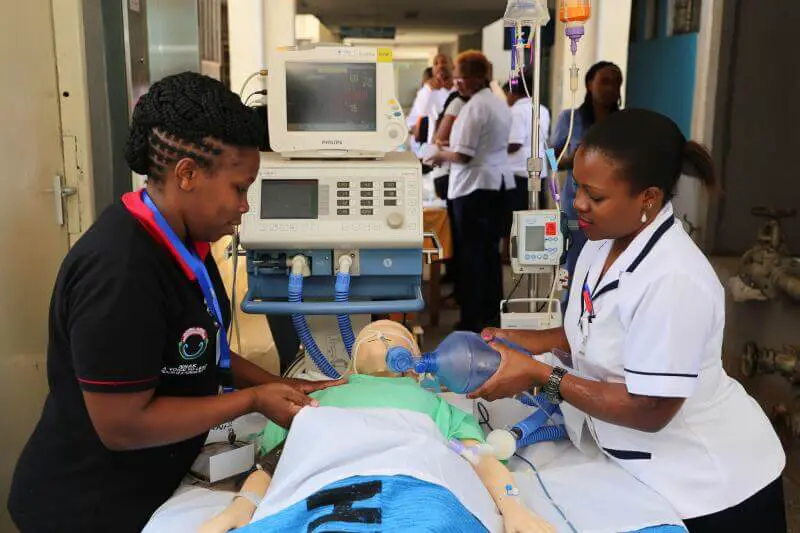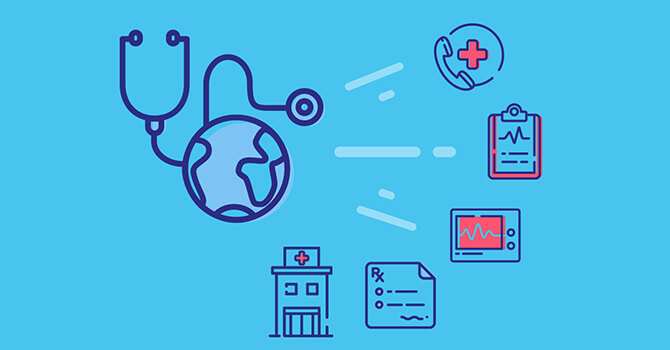The Kenya Health Information System (KHIS) is an open-source digital platform that is designed to capture, store, manage, and disseminate health-related data in Kenya.
It was launched by the Ministry of Health in 2009 in collaboration with other stakeholders in the health sector to improve the quality of health services and inform health policy-making.
Its use officially began in 2010.
It covers a range of health information needs, including patient information, disease surveillance, laboratory information, and supply chain management.
It‘s used in all health facilities in Kenya, from primary health clinics to referral hospitals.
What are the objectives of KHIS?
The main objective of KHIS is to provide timely and accurate information to health workers, health managers, policymakers, and other stakeholders to support evidence-based decision-making, planning, and monitoring of health programs.
It also enables the integration and sharing of health data across different levels of the health system.
KHIS is an important tool for improving the quality of health services in Kenya and ensuring that health resources are effectively allocated and utilized.
It has contributed significantly to improving health outcomes, reducing morbidity and mortality rates, and enhancing the efficiency and effectiveness of the health system.
How do you use KHIS?
The use of the Kenya Health Information System (KHIS) varies depending on the role of the user.
Health workers use it to capture patient data, track health outcomes, and report disease outbreaks.
Health managers use it to monitor program performance, allocate resources and make decisions.
Policymakers use it to inform policy-making and resource allocation.
To access KHIS data online, head over to hiskenya.org, enter your username and password (which are provided by the Ministry of Health when signing up) and log in.
What is KHIS Aggregate?
The KHIS Aggregate is a branch of the larger KHIS system.
It’s used by the Ministry of Health to collect, manage, and analyze health data from various health facilities across the country.
The system is designed to support health information management at all levels of the health system, from the national level down to the community level.
The KHIS Aggregate collects data on various health indicators, including maternal and child health, infectious diseases, non-communicable diseases, and other health-related topics.
The system is web-based and allows health facilities to enter and submit their data online, making it easier and faster to collect and analyze health information.
How to login to KHIS Aggregate
To log in to KHIS Aggregate, you need to create an account first.
You’ll need to come up with a username and password to create an account.
You’ll use the username and password to log in to the KHIS Aggregate database to access information on it.
What is the function of the KHIS Tracker?
The KHIS Tracker is a branch of the larger KHIS system.
It’s used to track and monitor health services and programs in Kenya.
The KHIS Tracker is designed to provide real-time information on the availability and utilization of health services, resources, and commodities at health facilities.
It helps to identify gaps and challenges in the health system and allows health managers to make informed decisions for improving the quality and efficiency of health services.
What is the function of KHIS Event Capture?
The Kenya Health Information System Event Capture (KHIS Event Capture) is another branch of the larger KHIS system.
It’s used to capture data on disease outbreaks and other public health events in real time.
It enables health workers to report outbreaks quickly and allows health managers to monitor and respond to public health emergencies effectively.

What is DHIS in Kenya?
The District Health Information System (DHIS) is an open-source, web-based platform used to collect, manage, and analyze health data at the district level.
What is the purpose of DHIS?
The system was established to improve the quality of health information management and to provide timely and accurate information for decision-making in the health sector.
The DHIS is designed to collect data on a wide range of health indicators, including disease surveillance, maternal and child health, immunization, and health facility management.
The system enables health managers to monitor health trends, allocate resources effectively, and make informed decisions for health policy and planning.
The DHIS has contributed significantly to improving the availability and quality of health information in Kenya and has helped to strengthen the country’s health system.
What is DHIS aggregate?
DHIS Aggregate is a branch of the District Health Information System (DHIS).
It’s used to collect, manage, analyze, and disseminate aggregated health data.
It allows for the aggregation of data from different health facilities and programs into a single platform, which is then used for monitoring and evaluation, planning, and decision-making.
DHIS Aggregate collects data on health indicators, such as disease prevalence, mortality rates, and service utilization, and can be used to generate reports and dashboards for various stakeholders.
What is DHIS policy?
The District Health Information System (DHIS) policy in Kenya is a framework that guides the collection, management, and use of health data at the district level.
It aims to improve the availability, quality, and use of health information for decision-making and planning.
How does DHIS2 operate?
DHIS2 Kenya is an open-source, web-based platform used for collecting, managing, and analyzing health data at different levels of the health system.
Data is entered into the system by health facility staff and other data sources, such as laboratory systems, and is then aggregated and analyzed at the district, county, and national levels.
DHIS2 Kenya is designed to be user-friendly and can be accessed from desktop computers, tablets, and mobile phones.
The platform is used for a range of purposes including health facility management, disease surveillance, supply chain management, and health service planning and delivery.
When was DHIS2 introduced in Kenya?
DHIS2 was rolled out in Kenya in 2010, as a replacement for the previous health management information system, which was paper-based and less efficient.
What is aggregate data in DHIS2?
Aggregate data in DHIS2 refers to health information that is collected, managed, and analyzed in the form of summary statistics for a given period, such as a month, two months, 6 months, etc.
This data is collected from different health facilities and programs and is aggregated at different levels of the health system, from the facility level up to the national level.
Aggregate data includes information on key health indicators, such as disease prevalence, mortality rates, service utilization, and health outcomes.
It is used for monitoring and evaluation, planning, and decision-making at all levels of the health system.
How do I log into DHIS2?
To log into DHIS2 Kenya, you will need a username and password provided by the Ministry of Health or your organization’s DHIS2 administrator.
You can access the login page through a web browser by entering the URL for your DHIS2 instance, and then entering your credentials in the login form.

What are DHIS2 indicators?
DHIS2 indicators are specific measures used to track progress towards achieving health goals.
These indicators are used to capture and report data on health-related events or activities and can include a wide range of measures such as disease incidence, mortality rates, service utilization, and health outcomes.
DHIS2 indicators are typically defined by the Ministry of Health or other organizations and are used for monitoring and evaluation of health programs, planning and resource allocation, and decision-making.
What is DHIS2 online data entry?
DHIS2 online data entry refers to the process of entering and submitting health data into the DHIS2 platform through a web-based interface.
It allows health workers and other authorized personnel to enter data directly into the system using a computer, tablet, or mobile phone with an internet connection, rather than using paper-based forms.
What is DHIS2 event Capture?
DHIS2 Event Capture is a component of the DHIS2 system that allows for the capture and reporting of health-related events or activities.
It is used to collect data on specific events or activities that occur at health facilities or in the community, such as disease outbreaks, immunization campaigns, and health education sessions.
Event data is entered into DHIS2 through a web-based interface and can include information on the date and location of the event, the number of participants, and any related health outcomes or interventions.
Event data can be used for monitoring and evaluation of health programs, as well as for planning and decision-making at different levels of the health system.
What is DHIS2 capture download?
DHIS2 Capture Download is an application that allows users to download and install a copy of the DHIS2 data entry module on their local computer.
This is useful in situations where the user may not have reliable internet connectivity or needs to work offline, as the data can be entered locally and then synchronized with the central DHIS2 server when a connection becomes available.
DHIS2 Capture Download is available for Windows, Mac, and Linux operating systems.
How do I capture data from DHIS?
To capture data from DHIS2, you’ll need to have access to the DHIS2 platform.
Once you have access, you can navigate to the data entry module and select the appropriate form for the type of data you want to enter, such as aggregate data or event data.
You will then need to fill in the required fields, which may include information such as the name of the health facility, the date of the event, and the relevant health indicators.
Once the data is entered, you can save and submit it, and it will be stored in the DHIS2 database for further analysis and reporting.
What is the difference between DHIS2 and the Health Management System (HMIS)?
DHIS2 (District Health Information System 2) and HMIS (Health Management Information System) are both software applications that are designed to support the management and analysis of health information.
However, there are some key differences between the two systems:
Scope
DHIS2 is a comprehensive health information system that covers all levels of the health system, from the community level up to the national level, and can be used to manage both aggregate and event-based data.
HMIS, on the other hand, is a more limited system that is used primarily for the collection and management of aggregate data at the facility level.
Flexibility
DHIS2 is highly customizable and can be adapted to meet the specific needs of different health systems and programs, while HMIS systems are often more rigid and may not allow for as much customization.
Technology
DHIS2 is a web-based platform that can be accessed from any device with an internet connection, while many HMIS systems may still rely on paper-based forms or require specialized software that can only be used on certain devices.
Open source
DHIS2 is an open-source software application, which means that it is freely available and can be modified and improved by the user community, while HMIS systems may be proprietary and require licensing fees or other restrictions.
In a nutshell, DHIS2 is a more comprehensive and flexible health information system that can be used for a wide range of health data management needs, while HMIS is typically more limited in scope and functionality.
What app is used in DHIS2 to collect aggregate data?
DHIS2 Web Capture is the app used in Kenya to collect aggregate data in DHIS2.
What are the main layers used to analyze aggregate data in DHIS2?
DHIS2 uses a multi-layered approach to analyzing aggregate data. The main layers used are:
- Data Entry: This layer involves the collection of raw data from health facilities, community health workers, and other sources.
- Data Validation: This layer involves checking the accuracy, completeness, and consistency of the data that has been collected.
- Data Aggregation: This layer involves combining and summarizing the data at higher levels of the health system, such as districts, regions, and the national level.
- Data Analysis: This layer involves using statistical and other methods to analyze the aggregated data, identify trends, and generate reports.
- Data Visualization: This layer involves presenting the analyzed data in a visual format, such as charts, graphs, and maps, to make it easier to interpret and communicate to stakeholders.
- Data Use: This layer involves using the analyzed data to inform decision-making, planning, and program management at different levels of the health system.
What was the rationale for adopting DHIS2 in Kenya?
The decision to adopt DHIS2 in Kenya was based on several factors, including:
- Need for a comprehensive health information system: Kenya recognized the need to have a robust health information system that could support the collection, analysis, and use of health data across all levels of the health system.
- Improved data quality: DHIS2 was seen as a tool that could help improve the quality and accuracy of health data by providing standard data definitions, validation rules, and other data quality checks.
- Interoperability with other systems: DHIS2 was designed to be interoperable with other health information systems, which made it easier to integrate with other health systems and data sources.
- Customizability: DHIS2 is highly customizable, which meant that Kenya could adapt the system to meet its specific health information needs and requirements.
- Open source: DHIS2 is an open-source system, which means that it is freely available and can be modified and improved by the user community. This made it an attractive option for Kenya, which could benefit from the contributions of a large and active DHIS2 user community.



